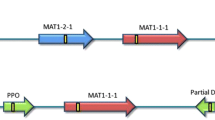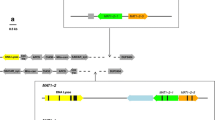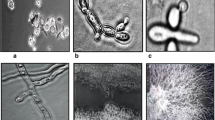Abstract
The nucleotide sequences of regions containing the mating-type locus of the plant-pathogenic ascomycete Leptosphaeria maculans are described. The MAT1-1 gene is 1,368 bp, encoding a predicted protein of 441 amino acids, with a 45-bp intron. The MAT1-2 gene is 1,246 bp, encoding a predicted protein of 397 amino acids, with a 55-bp intron. This latter gene is 334 bp downstream of a small open reading frame (32 amino acids) with four amino acids in identical positions to those in the high mobility group binding domain of the MAT1–2 genes. The DNA lyase and anaphase promoting complex genes are 3′ of the MAT gene, whilst a gene denoted ORF1 in Cochliobolus heterostrophus and the GTPase activating protein are present 5′ of MAT. The transcriptional patterns of genes within and flanking the L. maculans MAT locus are determined. The MAT transcripts are about twice the length of the gene. The ORF1 transcript is 1.2 kb in the MAT1-1 isolate and 1.0 kb in the MAT1-2 isolate; and probes cross-hybridise weakly. A mating-type PCR assay with three nucleotide primers is developed for L. maculans.





Similar content being viewed by others
References
Arie T, Christiansen SK, Yoder OC, Turgeon BG (1997) Efficient cloning of ascomycete mating type genes by PCR amplification of the conserved MAT HMG box. Fungal Genet Biol 21:118–130
Arie T, Kaneko I, Yoshida T, Noguchi M, Nomura Y, Yamaguchi I (2000) Mating-type genes from asexual phytopathogenic ascomycetes Fusarium oxysporum and Alternaria alternata. Mol Plant-Microbe Interact 13:1330–1339
Barrins JM, Purwantara A, Ades PK, SalisburyPA, Howlett BJ (2002) Genetic diversity of isolates of Leptosphaeria maculans from a canola (Brassica napus) paddock in Australia. Aust Plant Pathol 31:129–135
Cozijnsen AJ, Popa KM, Rolls BD, Purwantara A, Howlett BJ (2000) Genome analysis of the plant pathogenic fungus Leptosphaeria maculans: mapping mating type and host specificity loci. Mol Plant Pathol 1:293–302
Howlett BJ, Idnurm A, Pedras MSC (2001) Leptosphaeria maculans the causal agent of blackleg disease of brassicas. Fungal Genet Biol 33:1–14
Ito T, Chiba T, Ozawa R, Yoshida M, Hattori M, Sakaki Y (2001) A comprehensive two-hybrid analysis to explore the yeast protein interactome. Proc Natl Acad Sci USA 98:4569–4574
Leubner-Metzger G, Horwitz BA, Yoder OC, Turgeon BG (1997) Transcripts at the mating type locus of Cochliobolus heterostrophus. Mol Gen Genet 256:661–673
Poeggeler S, Kueck U (2000) Comparative analysis of the mating type loci from Neurospora crassa and Sordaria macrocarpa: identification of novel transcribed ORFs. Mol Gen Genet 263:292–301
Sexton AC, Howlett BJ (2000) Characterisation of a cyanide hydratase gene in the phytopathogenic fungus, Leptosphaeria maculans. Mol Gen Genet 263:463–470
Shoemaker RA, Brun H (2001) The teleomorph of the weakly aggressive segregate of Leptosphaeria maculans. Can J Bot 79:412–419
Turgeon BG (1998) Application of mating type technology to problems in fungal biology. Annu Rev Phytopathol 36:115–137
Venn LA (1979) The genetic control of sexual compatibility in Leptosphaeria maculans. Aust J Plant Pathol 8: 5–6
Waalwijk C, Mendes O, Verstappen ECP, Waard MA de, Kema GHJ (2002) Isolation and characterization of the mating-type idiomorphs from the wheat septoria leaf blotch fungus Mycosphaerella graminicola. Fungal Genet Biol 35:277–286
Williams RH, Fitt BDL (1999) Differentiating A and B groups of Leptosphaeria maculans, causal agent of stem canker (blackleg) of oilseed rape. Plant Pathol 48:161–175
Wirsel S, Horwitz B, Yamaguchi K, Yoder OC, Turgeon BG (1998) Single mating type-specific genes and their 3′ UTRs control mating and fertility in Cochliobolus heterostrophus. Mol Gen Genet 259:272–281
Yun SH, Berbee ML, Yoder OC, Turgeon BG. (1999) Evolution of the fungal self-fertile reproductive life style from self-sterile ancestors. Proc Natl Acad Sci USA 96:5592–5597
Acknowledgements
We thank Dr. A. Ashby, Dr. G. Turgeon and Dr. C. Waalwijk for advice on cloning the mating type locus and the Australian Grains Research and Development Corporation for funding this project.
Author information
Authors and Affiliations
Corresponding author
Additional information
Communicated by U. Kück
Rights and permissions
About this article
Cite this article
Cozijnsen, A.J., Howlett, B.J. Characterisation of the mating-type locus of the plant pathogenic ascomycete Leptosphaeria maculans . Curr Genet 43, 351–357 (2003). https://doi.org/10.1007/s00294-003-0391-6
Received:
Revised:
Accepted:
Published:
Issue Date:
DOI: https://doi.org/10.1007/s00294-003-0391-6




